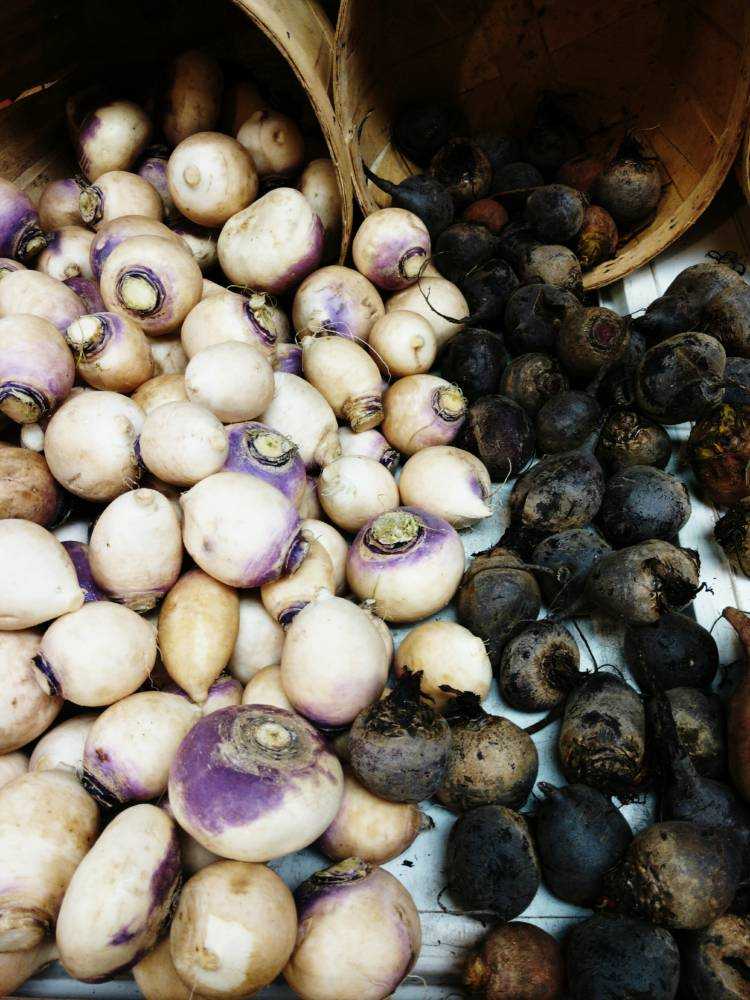BY: EARTHA LOWE
Roasting root vegetables define contemporary cooking! You can combine almost any vegetables you want, turning a simple dish into a dramatic one that’s low in fat, high in flavour, and that gets lots of vegetables into you. With roasting, the vegetables become sweeter, more intensely flavoured, and the outsides are slightly crispy and brown. To add, it usually isn’t much more work to cook several vegetables at once. Choose vegetables that will soften all at about the same time.
What is a Root Vegetable? Simply put, a root vegetable is one where the root of the plant is eaten. They keep for long periods of time (several months if stored properly) and are usually harvested in the fall. The list of root vegetables include yams; sweet potato; colourful beets and carrots; batata; parsnip; turnip; radish; garlic; onion; shallots; ginger; arrowroot; cassava (the root from which tapioca is made); fennel; rutabaga and turmeric.
Yam
The true yam is not a sweet potato. A yam is very bland, and when cooked, very dry. It is often used in meaty stews that contain plenty of liquid, wherever you’d use potatoes.
Parsnip
Sweeter than even carrots with a somewhat nutty taste, the highest and best use is pureed, but they’re also wonderful mixed with other vegetables in a roasting pan. When preparing parsnip, treat it as you would a carrot. You’ll know it’s done cooking when tender enough to easily pierce with a thin-bladed knife or a skewer. Overcooking makes parsnips mushy.
Beet
This root vegetable is crunchy, sweet, delicious, and can be eaten raw! Some varieties of beets are sweet enough to be used to make sugar. They’re also quite simple to prepare. One good indication of freshness is the presence of greens, which can be cooked separately like chard. Juice together, 2 medium beets, 3 medium carrots and 2 apples for a natural, energizing jolt. Scrub well before cooking.
Honey-Roasted Root Vegetables
You’ll need
- 1 large sweet potato, peeled and cut into 1-inch cubes
- 3 parsnips, peeled and cut into 1-inch rounds
- 4 medium carrots, cut lengthwise or into 1-inch rounds
- 2 large beets, peeled and cut into 1-inch cubes or wedges
For the dressing:
- 1/4 cup coconut oil, melted or extra-virgin olive oil
- 2 tablespoons raw honey
- 1 tablespoon dried oregano
- 1/2 teaspoon curry powder
- 1/2 teaspoon coarse sea salt, or to taste (optional)
- 1 teaspoon freshly ground black pepper
Directions
- Preheat the oven to 400ºF.
- Line two rimmed baking sheets with parchment paper.
- In a small bowl, mix together the ingredients for the dressing.
- In a large bowl, combine the sweet potato, parsnips and carrots. Add the dressing. Toss to coat the vegetables.
- Spread the vegetables into a single layer on the baking sheets.
- Add the beets to the large bowl with the leftover dressing and toss to coat. Spread into a single layer onto one of the baking sheets. The beets are prepared separately to prevent its vibrant colour from turning the other vegetables ruby red.
- Place the sheets in the preheated oven and bake the vegetables for 10 – 15 minutes. Turn them so they brown on the other side. Continue to bake the vegetables for 10 to 15 minutes more, or until brown and tender. Serve warm.
Food category: vegan, vegetarian
Prep and cook time: 45 minutes
Serves: 4
Difficulty: easy!

